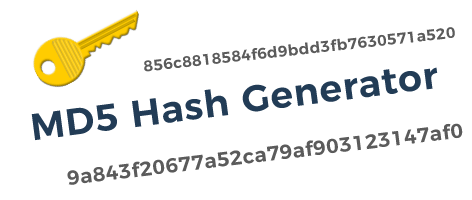What is MD5?
In the world of cybersecurity and data management, MD5 (Message Digest Algorithm 5) stands as a pivotal hashing algorithm that has been widely used for a variety of applications, including data integrity checks, password storage, and file verification. Despite concerns about its security vulnerabilities, MD5 continues to play a significant role in numerous fields, thanks to tools like the MD5 generator. In this blog post, we’ll dive into the ins and outs of MD5, how it works, and why an MD5 generator is an essential tool for digital professionals.
What is MD5?
MD5 stands for Message Digest Algorithm 5. It is a cryptographic hash function that produces a fixed-size (128-bit) hash value from an input message, whether that be a string of text, a file, or any other data type. Originally designed by Ronald Rivest in 1991, MD5 was widely adopted due to its simplicity and speed.
An MD5 hash is commonly represented as a 32-character hexadecimal number. This hash value is a "fingerprint" of the input data, providing a quick way to check for changes in the original data without having to inspect the entire content.
However, it’s crucial to note that MD5 is no longer considered secure for cryptographic purposes due to its vulnerability to collision attacks—a method where two different inputs produce the same hash value. Despite this, it remains a staple for certain applications, such as file verification, where speed and convenience are essential.
How Does an MD5 Generator Work?
An MD5 generator takes any input—whether it's a text string or a file—and applies the MD5 algorithm to produce a hash value. This value is a unique, 128-bit string that serves as a checksum for verifying the integrity of the original data. The MD5 generator is designed to work quickly and efficiently, offering fast hash computation.
Let’s break it down into simpler steps:
- Input: You enter a string of text or upload a file into the MD5 generator.
- MD5 Processing: The tool applies the MD5 algorithm to the input.
- Output: The MD5 generator outputs a 32-character hash value, representing the input.
For example, entering the text “Hello World” into an MD5 generator might yield the hash:
fc3ff98e8c6a0d3087d515c0473f8677
Why Use an MD5 Generator?
Even though MD5 is considered cryptographically weak, there are numerous scenarios where it’s still incredibly useful. Here are some of the primary reasons why an MD5 generator remains a go-to tool:
1. File Integrity Verification
One of the most common uses of an MD5 generator is to verify file integrity. When downloading software, files, or documents from the internet, many websites provide an MD5 hash value alongside the download link. After downloading the file, you can use an MD5 generator to check if the hash value matches. If they match, you can be confident that the file hasn’t been tampered with during the download process.
2. Password Storage and Verification
Though MD5 is not recommended for secure password storage due to its vulnerabilities, it is still used in legacy systems for basic password hashing and verification. When a password is input, the system hashes it using MD5, stores the hash, and compares it during subsequent login attempts.
3. Efficient Data Comparisons
MD5 is often employed to compare large datasets or files. By generating and comparing the MD5 hash values of different files, you can quickly identify any discrepancies, rather than manually inspecting the files themselves. This is especially useful in software development, file management, and data migration projects.
4. Digital Signatures
While MD5 is not suitable for cryptographic signatures in modern security protocols, some systems still use MD5 hashes for digital signatures, where the hash of a message is signed and used for verification.
How to Use an MD5 Generator
Using an MD5 generator is straightforward. Follow these steps to generate an MD5 hash:
- Choose an MD5 Generator Tool: There are many free online MD5 generators available, such as MD5Online, XOR Data, and MD5 Hash Generator. Alternatively, developers can use libraries in languages like Python or JavaScript to generate MD5 hashes programmatically.
- Input Your Data: Copy and paste the text into the input field or upload the file for which you want to generate an MD5 hash.
- Generate the Hash: Hit the “Generate” or “Compute” button, and the tool will quickly generate the MD5 hash for your data.
- Verify the Result: Compare the hash with the original or expected hash value to check for integrity.
MD5 Limitations and Alternatives
Although MD5 remains a powerful tool for file verification, it has its limitations:
- Vulnerability to Collision Attacks: As mentioned earlier, MD5 is no longer secure for cryptographic purposes because two different inputs can result in the same hash.
- Not Suitable for Secure Applications: If you're looking to secure sensitive data, MD5 should not be your go-to algorithm. Instead, consider using more secure hash functions like SHA-256 or SHA-3.
Conclusion
The MD5 generator remains a valuable tool for many use cases, despite its known vulnerabilities in cryptographic contexts. Whether you're verifying file integrity, comparing datasets, or working with legacy systems, the MD5 hash function offers a quick and easy way to generate unique fingerprints of your data.
However, for applications requiring high security, always consider upgrading to more secure alternatives like SHA-256 or bcrypt. MD5’s simplicity and efficiency, paired with the power of an MD5 generator, make it an indispensable tool in the world of data management.
By understanding the basics of MD5 and how to use an MD5 generator, you can ensure the integrity of your data while keeping your workflow efficient and effective.
